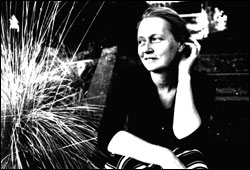O, Say a Sunset is a new “staged song cycle” created by Seattle-based composer/ vocalist Robin Holcomb exploring the life of environmental pioneer Rachel Carson. The show, directed by Seattle’s Nikki Appino, with musical direction by Holcomb’s husband Wayne Horvitz, will be at On the Boards (8 p.m. Fri., Oct. 10-Sat., Oct. 11, 206-217-9888). Holcomb’s band includes two of Seattle’s most interesting musicians (Eyvind Kang, Aiko Shimada), and the cast features two favorite local actors: Julie Rawley and Susanna Burney. The show has just returned from several East Coast performances; we sent New York arts writer Daniel King to preview the show two weeks ago at Dance Theatre Workshop in Manhattan.
SURE, RACHEL CARSON’S Silent Spring inspired JFK’s studies on insecticides and helped save Florida’s Everglades. She became the first woman to pass the civil service test, and, ultimately, she is the mother of the modern environmental movement. But she was also haunted, conflicted, gnawed at, by writer’s block and the demands of high-profile activism. That’s according to Holcomb, whose multimedia reflection on the biologist’s life portrays her as a confident, yet tattered, heroine. F. Scott Fitzgerald said, “You show me a hero, and I will write you a tragedy” and Holcomb comes close to that promise.
Holcomb based Sunset‘s script on letters exchanged between Carson and her friend Dorothy Freeman. Played by Rawley and Burney, respectively, both women wear their hair in tight librarian buns, their eyes appear as glassy shrouds, and thick wool sweaters weight their meaty, linebacker shoulders.
Holcomb plunks the piano keys with rich, ringing consonance and sings every syllable so clearly that you can hear the saliva against her lips. At times, her throaty vibrato sounds more cartoonish than credible, given her insistence on high-register wobbles. She demands so much from that twangy vibrato that she ends up draining it of subtlety. But her sharp lyrics and crisp chords compensate, especially alongside Eyvind Kang’s decorative plucks on viola and Aiko Shimada’s powdery, weightless hums. The band plays so atmospherically it sometimes detracts from the action onstage. Other times, the group’s hypnotism is the narrative, providing eulogies for the disappearing songbirds.
On-screen is Britta Johnson’s collage of moving natural images: waves crash against sand, airplanes plummet from the sky, flies undergo nasty dissectiongory, serene, microscopic events. Animal cruelty and human empathy take center stage in these films, but then, so do simplicity and peacefulness, with the faint sounds of seagulls crying, kids whistling, water lapping. Johnson’s minimalist footage sedates the audience, as does Kang on viola. With scraggly beard and crumpled forehead, he applies seductively gentle pressure to his instrument’s bridge, achieving spare, colorful, ambient sounds.
But why does Carson deliver passionate lines in such a stoic monotone? Seems strange, given that the songbirds she’s talking about sing melodically, not robotically. Carson’s stares are blankly neutral, her expressions lifeless. Her deadpan delivery contrasts strangely with the celebration of nature’s fanciful unpredictable patterns. Perhaps she has simply been crushed by what she sees around her, and as a result, has removed passion from her voice. “We have lost respect for life other than our own,” she says, “And after Hiroshima, I wonder whether we haven’t lost it for ourselves.”
Lighting designer Ben Geffen injects coy irony at every turn. Looking up into the darkness, Carson says, “It is never dark,” cuing overhead lights to spear her like an olive. At another point, darkness engulfs the stage and the band erupts into loud, chortling honks. The accordion rattles, the viola snorts, the guitar belches. Tension builds until a single light slams against Carson’s dress. She removes that dress to reveal fleshy, curvaceous arms, then steps into a birdlike cape.
THE MOST WELL-CRAFTED moment comes when Carson, a stickler for precision, places eight sheets of paper at disturbingly exact intervals by her feet, and struggles with writer’s block at a typewriter. Moments later, she’s typing loudly, sending crisp, steely percussion into the quintet’s moody dreamscapes. Freeman enters and sweeps the pages offstage, returning the floor to its sterile, uncluttered state. Everything looks tidy now, like Maryland before Hurricane Isabel. And with the rage and aggression of that ass-kicking storm, the band grows angry, violent, abrasive, sounding off like foghorns declaring war, an attack motif that climaxes steadily before dissolving into a midregister chug. This music is brittle, pounding, exciting, and brilliant.
But for all the noise, nexuses, and bird/flight/airborne imagery, the metaphors themselves rarely take off. Subtlety would enhance the symbolism a bit, as it does when Freeman carries a fake purple jellyfish dangling from a bent fishing rod. Casualties of fishing, you might call this imagery. It works well because it’s set to somber, stoic music that incorporates descending scales, aching blue notes, and sluggish rhythms.
Holcomb, weary from the workout, bows at the end, but never removes Carson’s mask to explain or abstract its contents. Instead, she has examined that mask.




